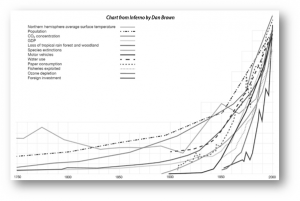The first time overpopulation is brought up in Inferno, Zobrist claims that population growth is exponential.
Additionally, he presents these two graphs to strengthen his point, which supposedly show exponential population growth.

Zobrist wants to show the link between population growth and other problems we face (such as C02-emissions, forest depletion, etc.)
However, in reality population growth only seemed to be exponential until approximately the 1970‘s and since then its rate has decreased immensely and continues to do so.
Here is a comparison of the actual population growth and what exponential growth would look like.
As you can see we would have reached 16 billion in the 1980‘s if it were exponential. But according to the UN and other estimates, population size will peak between about 8 and 11 billion around 2050 and will then start to slowly decline.
The view Brown presents turns out to have been popular in the 1970‘s following “The population Bomb” by Paul Ehrlich in which he wrote about the imminent dangers of what looked like exponential growth back then.

